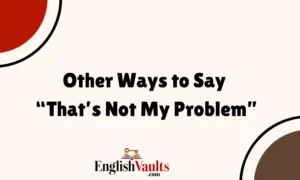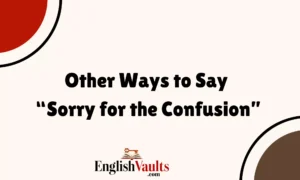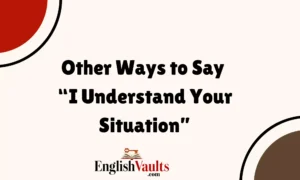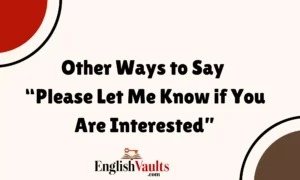In professional and everyday communication, expressing the concept of “similar but different” can be challenging. It involves acknowledging the likeness between two entities while highlighting their distinct variations. This nuanced distinction is important for clarity, especially when discussing products, ideas, or concepts that share commonalities but also have unique attributes.
Using alternative phrases to convey this idea can enhance your communication by providing more precise or varied expressions. Whether you’re drafting a report, engaging in a collaborative discussion, or presenting comparative analyses, choosing the right wording can make your message clearer and more impactful. In this article, we’ll explore 25 alternative ways to articulate the notion of “similar but different,” each with scenarios to illustrate their application. These expressions will help you effectively convey nuanced differences while acknowledging commonalities.
List of Other Ways to Say “Similar But Different”
- Closely Related Yet Distinct
- Comparable with Variations
- Parallel but Unique
- Resembling but Not Identical
- Similar in concept but Different in Execution
- In the Same Vein Divergent
- Analogous Yet Differentiated
- Like but with Variances
- Corresponding but Not the Same
- Related but Varied
- Matching but Distinct
- Akin Yet Diverse
- Homologous but Differing
- Resemblant but Divergent
- Equivalent with Differences
- Similar in Nature but Different in Detail
- Commensurate but Disparate
- Near Analogues but Different
- Similar Attributes but Different Aspects
- Convergent but Not Identical
- Parallel with Distinctions
- Similar Yet Set Apart
- Aligned but Divergent
- Closely Aligned but Distinct
- Comparable in Some Ways but Not in Others
1. Closely Related Yet Distinct
Scenario:
Hi Leo,
I appreciate your suggestion about integrating new features into our software. The proposed functionalities are closely related yet distinct from the ones we already have. For instance, the new user interface improvements align with our current design principles but introduce unique elements that will enhance user experience. I’ll review these changes and discuss them with the team to see how we can best incorporate them.
Best regards, Henry
Addition: Use this phrase when discussing ideas that share a core concept but have distinct variations that warrant separate consideration or implementation.
2. Comparable with Variations
Scenario:
Dear Leo,
Thank you for sending over the latest marketing strategies. They are comparable with variations to the approaches we’ve used previously. While the underlying goals remain the same, the new strategies propose different tactics to reach our audience. I look forward to exploring these variations further to determine which will be most effective for our upcoming campaign.
Best, Henry
Addition: Ideal for situations where there are similarities in approach or concept but notable differences in methods or details.
3. Parallel but Unique

Scenario:
Hi Leo,
The new software development framework you’ve recommended is parallel but unique compared to our existing framework. Both frameworks aim to enhance performance, but the recommended one offers additional features that set it apart. I will arrange a meeting to discuss how these unique aspects could benefit our project.
Best regards, Henry
Addition: Useful when two things serve similar functions but have distinct features or qualities that make each one unique.
4. Resembling but Not Identical
Scenario:
Hello Leo,
Your new design proposal resembles but not identical to the one we previously discussed. While it shares the same basic layout, the modifications you’ve suggested introduce several new elements. Let’s review these differences in our upcoming meeting to ensure they align with our brand objectives.
Best, Henry
Addition: This phrase highlights that while there are similarities, the differences are significant enough to be noted.
5. Similar in Concept but Different in Execution
Scenario:
Hi Leo,
The idea you presented for the project is similar in concept but different in execution from our current strategy. Both approaches aim to achieve the same outcome, but the methods and processes are varied. I suggest we examine the execution details to evaluate how they could impact our results.
Best regards, Henry
Addition: This is appropriate when two concepts have the same goal but differ in how they are implemented or executed.
6. In the Same Vein but Divergent
Scenario:
Dear Leo,
The recent proposals are in the same vein but divergent from what we’ve been working on. They maintain the core idea but offer different approaches or solutions. I’ll organize a session to delve into these divergent methods and assess their potential benefits.
Best, Henry
Addition: Use this phrase when ideas are fundamentally similar but have divergent methods or strategies.
7. Analogous Yet Differentiated
Scenario:
Hi Leo,
The new marketing plan you suggested is analogous yet differentiated from our existing strategy. It follows a similar structure but introduces new techniques to target different market segments. I’ll review these differentiations to see how they could enhance our overall approach.
Best regards, Henry
Addition: Suitable for discussing strategies or plans that are similar in form but have different elements or focuses.
8. Like but with Variances
Scenario:
Hello Leo,
Your draft for the new website design is like but with variances compared to our initial concept. The overall theme remains consistent, but the variances in layout and color schemes provide a fresh perspective. I’m excited to see how these changes could improve user engagement.
Best, Henry
Addition: This phrase highlights similarities while acknowledging specific differences that add unique aspects.
9. Corresponding but Not the Same
Scenario:
Hi Leo,
The two project proposals are corresponding but not the same. They both aim to address the same issue but differ in their approach and scope. Let’s discuss these differences to determine which proposal better aligns with our objectives.
Best regards, Henry
Addition: Use this to describe proposals or ideas that address the same problem but with different methods or solutions.
10. Related but Varied
Scenario:
Dear Leo,
The two reports are related but varied in their findings. Both address the same topic but offer different insights and conclusions. I will compare the reports and share a summary of how these variations might impact our decision-making process.
Best, Henry
Addition: Useful for documents or findings that are on the same topic but present varied perspectives or data.
11. Matching but Distinct
Scenario:
Hi Leo,
The new software tools are matching but distinct from the ones we currently use. They offer similar functionalities but with distinct features that could enhance our workflow. I suggest we evaluate these distinctions to see how they might benefit our operations.
Best regards, Henry
Addition: This phrase is helpful when discussing tools or features that are similar in purpose but have unique characteristics.
12. Akin Yet Diverse
Scenario:
Hello Leo,
The project timelines you’ve proposed are akin yet diverse compared to our previous schedules. They follow a similar pattern but incorporate different milestones and deadlines. We should review these diverse elements to ensure they align with our overall project goals.
Best, Henry
Addition: Ideal for comparing timelines or schedules that follow a similar structure but have different details.
13. Homologous but Differing
Scenario:
Hi Leo,
The two marketing campaigns are homologous but differ in their target audiences. Both campaigns share a similar core message but cater to different demographics. I recommend we analyze these differences to tailor our approach more effectively.
Best regards, Henry
Addition: Use this when comparing campaigns or strategies that have similar objectives but target different audiences.
14. Resemblant but Divergent

Scenario:
Dear Leo,
The new business models are resemblant but divergent from our current approach. They share the same fundamental principles but differ in their execution and market focus. Let’s discuss these divergences to identify the best fit for our company’s needs.
Best, Henry
Addition: Suitable for discussing business models or strategies that have similar foundations but different implementations.
15. Equivalent with Differences
Scenario:
Hi Leo,
The two design concepts are equivalent with differences in their elements. While they aim to achieve the same aesthetic goal, the differences in color schemes and layouts offer distinct visual impacts. We should evaluate these differences to choose the most effective design for our brand.
Best regards, Henry
Addition: This phrase highlights that while the concepts are similar in their objectives, they differ in execution.
16. Similar in Nature but Different in Detail
Scenario:
Hello Leo,
The two research studies are similar in nature but different in detail. Both explore the same subject but use varying methodologies and focus on different aspects. I’ll review these details to understand how they might influence our approach.
Best, Henry
Addition: Use this when the overall subject is similar but the details or methods differ.
17. Commensurate but Disparate
Scenario:
Hi Leo,
The project proposals are commensurate but disparate in their approaches. They both aim to deliver the same results but use different methods and strategies. Let’s analyze these disparate elements to determine which approach aligns better with our goals.
Best regards, Henry
Addition: Useful for comparing proposals that have the same objectives but different methods or strategies.
18. Near Analogues but Different
Scenario:
Dear Leo,
The proposed solutions are near analogs but different from what we’ve implemented so far. They share similar principles but vary in execution and expected outcomes. I suggest we examine these differences to determine their potential impact on our project.
Best, Henry
Addition: This phrase helps discuss solutions that are similar but have distinct differences.
19. Similar Attributes but Different Aspects
Scenario:
Hi Leo,
The two product designs have similar attributes but different aspects. Both are intended to serve the same function but differ in terms of user interface and features. I’ll review these aspects to evaluate which design better meets our users’ needs.
Best regards, Henry
Addition: This phrase is useful for comparing designs or products that have common features but different characteristics.
20. Convergent but Not Identical
Scenario:
Hello Leo,
The two strategic plans are convergent but not identical in their goals. They both aim to achieve similar outcomes but use different approaches and tactics. I propose we discuss these plans further to determine the best strategy for our objectives.
Best, Henry
Addition: Ideal for comparing strategies or plans that aim for the same goal but have different approaches.
21. Parallel with Distinctions
Scenario:
Hi Leo,
The new proposals are parallel with distinctions to our previous methods. They follow a similar framework but introduce specific changes that set them apart. I’ll schedule a meeting to review these distinctions and assess their potential benefits.
Best regards, Henry
Addition: Use this when discussing proposals or methods that have a similar framework but include notable changes.
22. Similar Yet Set Apart
Scenario:
Dear Leo,
The project ideas are similar yet set apart by their unique features and applications. They share a common goal but differ in execution and scope. Let’s explore these differences to understand how each idea can contribute to our overall strategy.
Best, Henry
Addition: This phrase is suitable for discussing ideas that have a shared goal but are differentiated by unique features.
23. Aligned but Divergent

Scenario:
Hi Leo,
The two development approaches are aligned but divergent in their methods. They both aim to improve our product but follow different paths to achieve this goal. I recommend we evaluate these divergent methods to select the best approach for our needs.
Best regards, Henry
Addition: Use this when methods or approaches align with their objectives but differ in their execution.
24. Closely Aligned but Distinct
Scenario:
Hello Leo,
The new marketing strategies are closely aligned but distinct from our current plan. They follow a similar strategic direction but offer different tactics and messaging. I’ll review these distinct elements to determine how they can enhance our overall marketing efforts.
Best, Henry
Addition: Ideal for discussing strategies that are aligned with their goals but have distinct differences in their approach.
25. Comparable in Some Ways but Not in Others
Scenario:
Hi Leo,
The proposed solutions are comparable in some ways but not in others. They both address the same issue but vary significantly in their implementation and impact. Let’s examine these comparisons to choose the most effective solution for our project.
Best regards, Henry
Addition: This phrase is helpful for discussing solutions or methods that have similarities but also notable differences.










